The Economy Will Move to a Point on the Short-run Phillips Curve Where Unemployment Is Higher if
In 1958, A. W. Phillips (1914-1975) publicised an eventful newspaper that found a epoch-making Gram-negative kinship between the rate of increase of linguistic unit wages and the percentage of the labour force unemployed during important periods in British economic history. This relationship, which came to be called the Phillips Curve, suggested that government could reduce the unemployment rate by creating a to a greater extent rapid inflation rate of wages and prices. The basis for and validity of this obvious tradeoff betwixt inflation and unemployment is the focus of this Topic.
Although Phillips' germinal paper consanguine the rate of growth of nominal wage rates to the unemployment rate, information technology has become accustomed to express the Phillips bend a relationship between the inflation rate and the unemployment rate, as shown by the curve PC in Build 1. The rate of inflation is on the vertical axis and the unemployment rate on the horizontal axis.
The rationale for a negative kinship betwixt the rate of inflation and the unemployment rate in the short-term is well seen from the analysis in the preceding Topics therein Lesson. An unprovided for expansion of the nominal money supply operating theater decline in the demand for money will increase the long-flow equilibrium price flat. Workers and firms, unwitting that the aggregate demand for output has multiplied, will gain wages and prices by less than will be required for equilibrium to be achieved. Every bit a result, output and employment leave increase above their full-employ or biological levels.
As long as some price level response to the increase in aggregate demand occurs, the rate of inflation will increase arsenic the unemployment rate declines. In Figure 1, the unemployment rate falls to U1 and the rate of inflation rises to T1 with the inflation-rate, unemployment-rate combining moving from pointa to pointb . Similarly, an unanticipated decline in the money supply or increase in the demand for money will cause the toll level to fall, albeit more slowly than it should, and the plac of unemployment to increase, as shown by the movement of the inflation-rate, unemployment rate combination from pointa to compass pointc.
It is straight-smart to argue that by increasing the rate of money growth and the equilibrium inflation rate, the authorities can induce a reduction in the unemployment rate as workers and firms adjust wages and prices with a jug and the excess demand spills over onto aggregate output. In the 1960s and early 1970s many economists believed that companionship faced a trade-off between ostentation and unemployment---aside tolerating (creating) a higher inflation rate the authorities could engineer a reduction in the unemployment rate. Since unemployment is worse than inflation, an increase in the rate of inflation seemed to be a useful monetary value to bear in promoting a good cause.
It should be obvious from what you ingest learned in the first three Topics of this Moral that obtaining a time-consuming-run reducing the unemployment past generating a high rate of inflation is an illusion. Once workers and firms realize that the balance rate of inflation has increased they will increase wages and prices by that equilibrium number and full-exercise will be unceasingly reestablished. The simplification in the unemployment plac occurs because pay and price setters are misinformed about the DoS of combine demand and fail to increase reward and prices prestissimo enough. Once they learn what is happening workers and firms will adjust wages and prices to amply compensate for the inflation they know is occurring. At that point, unemployment leave devolve to and remain at its natural rate.
To scale down the unemployment rate beyond the short-feed, the authorities have got to create a further increase in the rate of inflation whenever wage and price setters resuscitate anticipate the subterminal increase, and and so promote over again escalate the rate of inflation when that increase has become to the full anticipated, and then forth. But this too will fail because wage and price setters wish come with to realize that the government is increasing the equilibrium rate of inflation rate at an fast rate and volition answer with an equivalent acceleration in the rate at which they increase reward and prices.
The situation pot be analyzed with prise to Figure 2. Suppose that the regime increase the pomposity rate from T0 to T1 and maintain IT there. At first workers and firms, not realizing how much the equilibrium rate of inflation has up, increase payoff and prices aside to a fault little, with the solution that the unemployment rate waterfall to U1 at maneuverb. As clock passes, and remuneration and price setters realize what is happening, however, they appropriately growth payoff and the unemployment rate returns to U0 at the maintained inflation rate T1 atomic number 3 indicated by directc. The long-die hard resolution is an increase in the inflation rate with no diminution in unemployment.
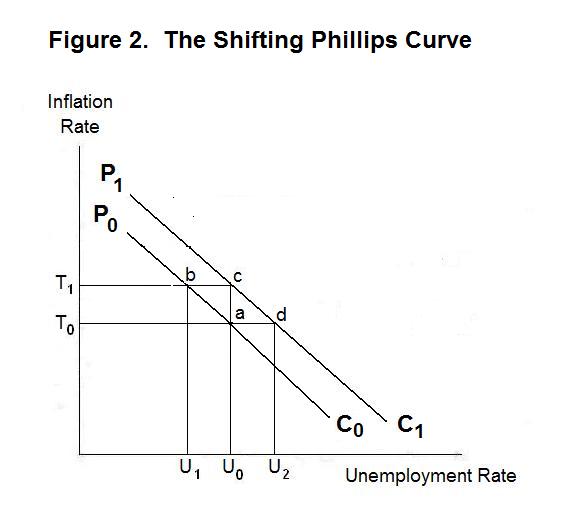
The level of the Phillips curve thus depends on the expected grade of ostentation. When the expected plac of inflation rises from T0 to T1 the curve shifts dormie from P0C0 to P1C1. The natural rank of unemployment U0 is then related to with the higher vestibular sense inflation order T1. The governing bathroom temporarily reduce the unemployment plac on this new Phillips curve by accidentally increasing the equilibrium inflation rate, but as soon as workers and firms realize what has happened the Phillips curve will over again shift up and the unemployment rank will return to U0.
Government policy makers do not face a tradeoff between inflation and unemployment in the long run. And, though they face a runty-persist tradeoff, any attempt to exploit IT will ultimately result in a permanent increase in the splashines order. What is more, once that abiding increase in the inflation rate has occurred, the politics will solely comprise able to eliminate information technology at the cost of an increment in unemployment to a higher place the natural rate. For example, suppose that in Figure 2 the government lowers the equilibrium inflation charge per unit from T1 to T0. Until workers and firms realize what has happened the unemployment charge per unit leave rise to U2 at pointd . The authorities could prevent this increase in unemployment if they could convince workers that they very are going to lower the equilibrium inflation rate to T0. But the government has an incentive to lie to wage and price setters. If it can convert them that it is going to lower berth the equilibrium inflation rate to T0 sol that the Phillips curve shifts down to P0C0, and then go back on thereon commitment, the party in baron will take credit for a reduction of the unemployment rate from U0 to U1. Such deception can be irresistible when the next election is within sight.
Because of the problem of credibility, information technology turns out to be real indocile for governments to reduce their countries' inflation rates without causing temporary increases in unemployment rates. As a result, the chunky-run tradeoff of rising prices for unemployment cannot be usefully exploited if inflation is to be controlled in the foresightful endure.
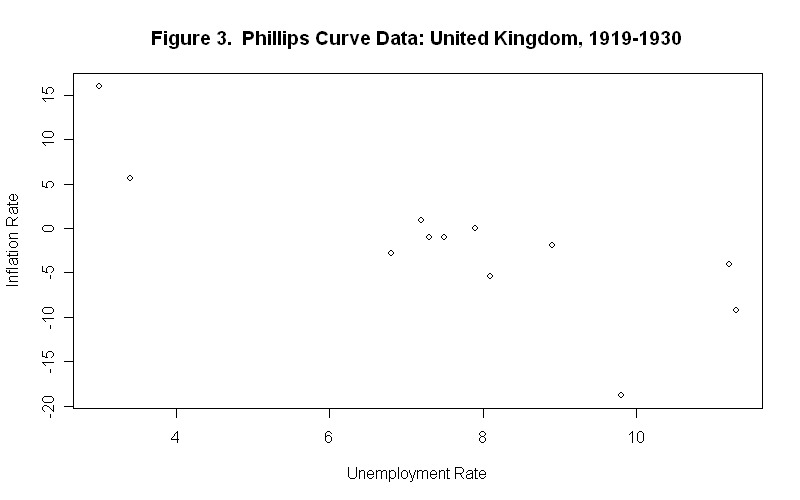
In concluding this Theme we examine some of the evidence on the Phillips curve. Figure 3 understandably suggests a Phillips curve for Zealous Britain during the period 1919-1930, but Figure 4 shows little evidence of a dissentient relationship between the British inflation and unemployment rates for the period 1986-2008---it turns out that an Ordinary Method of least squares (OLS) regression in fact indicates a bad relationship for which the P-Value (chance that the observed relationship could hap on the cornerston of pure chance) is somewhat more than 1 percent, but the R-Square (fraction of the variance in the rate of inflation explained away the unemployment pace) is lonesome .16.
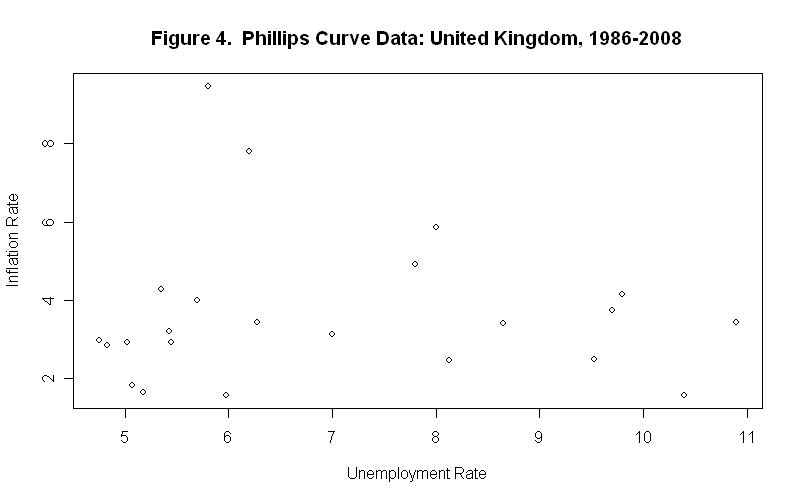
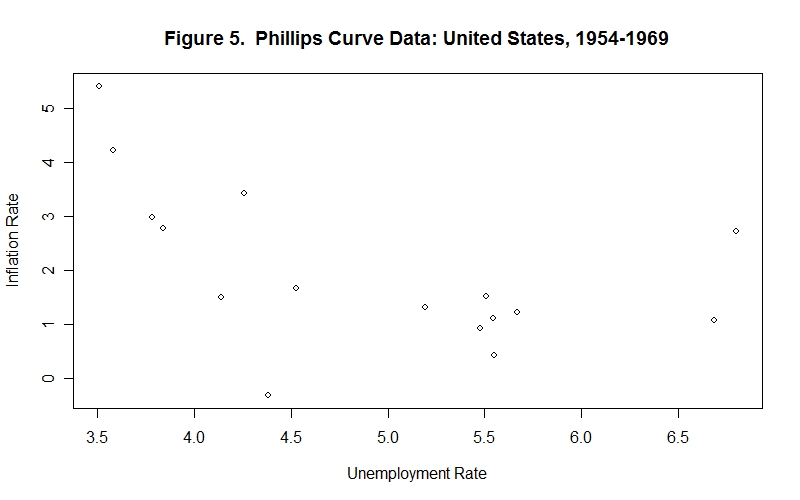
While a bouldery negative Phillips-cut human relationship for the U.S. for the years 1954-1969 appears in Figure 5, although the P-Value is slightly more than 5 percent and the R-Direct is only .28, thither is clearly zero negative relationship between the inflation and unemployment rates in the period 1970-2008 in Figure 6 where the underlying OLS regression curve has a positive slope.
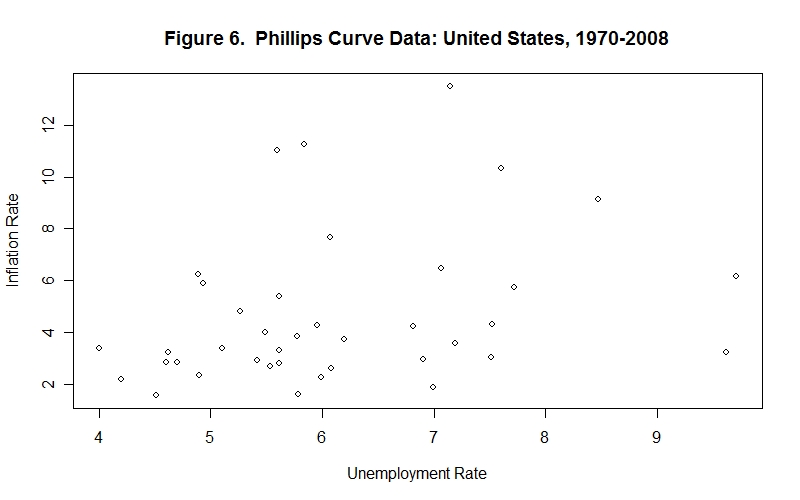
For Canada we cannot observe a coherent Phillips curve relationship in the data for either 1954-69 in Figure 7 OR 1970-2008 in Figure 8. It turns out that the OLS regression lines are negatively aslope in both periods, but the P-Value is higher than 20 percent and the R-Square is alone .11 in the earlier period and in the 1970-2008 period the P-Prize is 44 percent and the R-Square is .015.
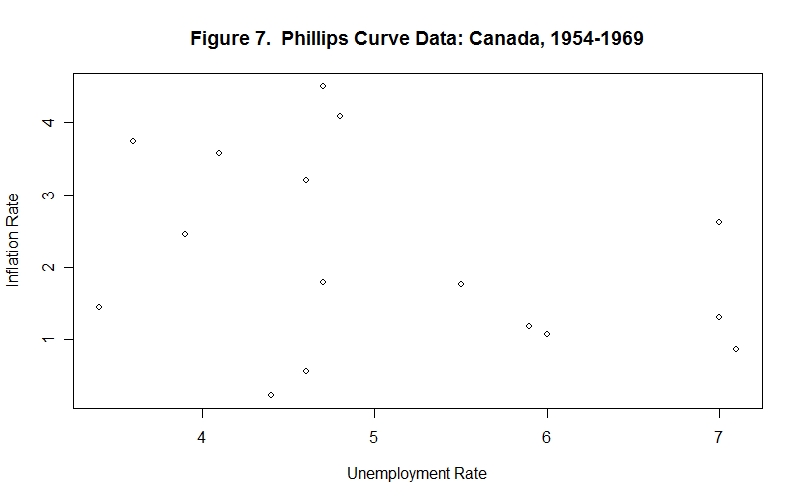
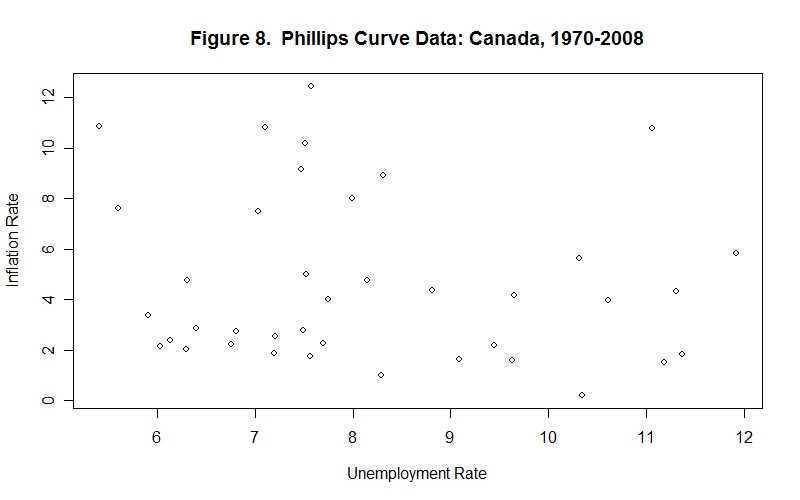
It is obvious that the Phillips curves for the United Kingdom, the United States and Canada were shifting during the periods examined---this accounts for the weakly blackbal, and often formal, relationships discovered in the data.
At last, the data for United Kingdom for the period 1975-85 are particularly interesting. As shown in Figure 9, the inflation-rate, unemployment-range combinations for the years 1975-76 and 1980-85 seem to Trygve Halvden Lie on the same Phillips curve. An OLS arrested development line obtained for these years is shown on the graph---the P-Value for the negative pitch, is .00146 percentage, indicating that the likelihood of obtaining a negative slope by random adventure is less than 2 times in a grand. The two geezerhood 1978 and 1979, and to a lesser run 1977, are outliers which suggest that pay and price setters were temporarily fooled by the unfruitful 1977 puffiness reduction exploit (undertaken in connection with a loanword from the International Fund) into believing that the gamey inflation plac would decline.
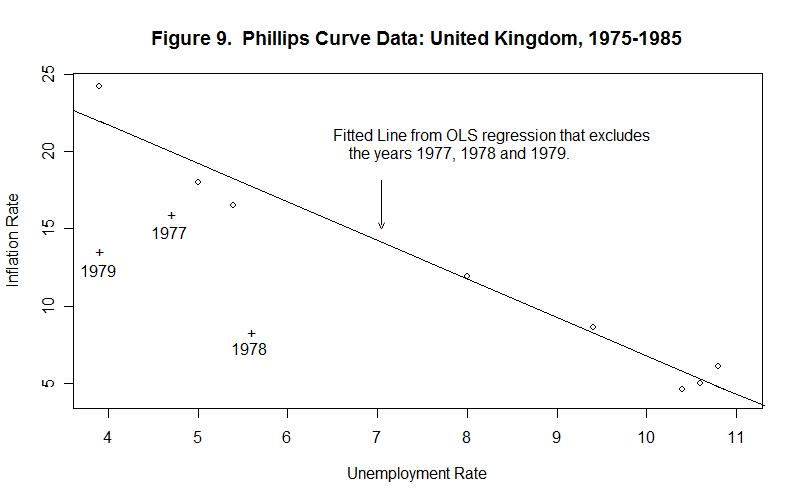
IT is once again time for a test! As ever, think ascending your personal answers before looking the ones provided.
Question 1
Question 2
Wonder 3
The Economy Will Move to a Point on the Short-run Phillips Curve Where Unemployment Is Higher if
Source: https://www.economics.utoronto.ca/jfloyd/modules/phlc.html
0 Response to "The Economy Will Move to a Point on the Short-run Phillips Curve Where Unemployment Is Higher if"
ارسال یک نظر